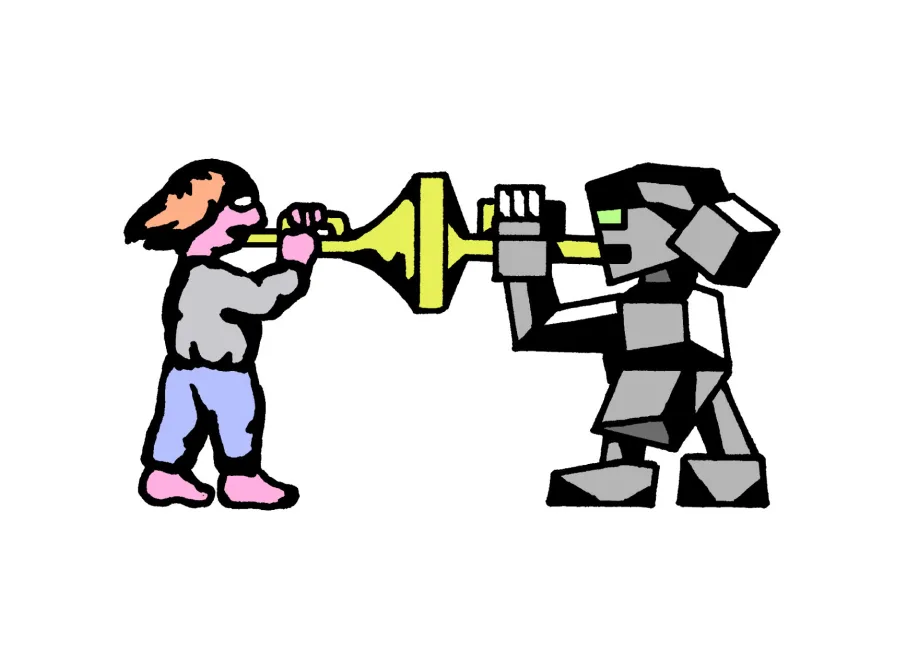

We’ve all enjoyed some of the freedom that came with the post-pandemic hybrid remote working model. But it was unprecedented, and as such, studies and data on the reality of what “wfh” means were not readily available. A few years on and it’s safe to call it: not being in an office comes with major problems for employee satisfaction, career development and psychological health more generally. Writer Alex Moshakis investigates in this latest Stuff They Don’t Tell You column.
When Anna began her first job, in October 2021, a few months after she graduated, she was asked to work entirely from home. As a journalist at a national newspaper, she was asked to write six news stories a day and was required to get to grips with her publisher’s content system, through which she would file her work, as quickly as possible. But she was aware there were additional on-boarding tasks to complete. She needed to form relationships with her boss and her new colleagues, many of whom she’d never met in person but on whom she relied for help and valuable information. And though it was not strictly a requirement, she realized it was crucial to become familiar with the culture of her new workplace—its norms and its language—in order to better fit in, and ultimately to progress.
Getting a sense of how things happen at a workplace—who to ask for what, where to go for help, even what jargon to use—is tricky for any new employee, even when they work full-time in an office and are surrounded by experienced staffers who might help them to understand the company dos and don’ts. It is even more difficult while working remotely.
The pandemic ushered in a new standard of permanent hybrid working among office workers, including those in the creative industry, and the change has had an outsized effect on young people entering the workforce. While prior to 2020 new starters were encouraged to immerse themselves in office life, to learn directly from those around them and to form constructive personal relationships with their colleagues, young creative people who have entered the workplace since 2020 have experienced novel, mostly distant working practices.

An email from a new employee that contains more than a few questions begins to look cumbersome to its recipient.
“It was hard,” Anna, who asked we not use her full name, told me recently about her first few months at work. “A lot of people, walking into their first job, have a million questions. But asking a million questions over Google Chat, or email, you feel like you’re bothering people, even when they say you aren’t.” An email from a new employee that contains more than a few questions begins to look cumbersome to its recipient, who is usually a busy boss. And answers to those questions aren’t always forthcoming, or prompt yet more questions. “In person, you can ask someone what they mean by a particular comment,” Anna said. “But in a message you can’t be, like, ‘What?’”
When Anna first started, her boss was conscious of and receptive to her needs as a recent graduate new to office life. “She put in the time to make things OK for me,” Anna said. “She trusted me to get on with things. And I was always given reassurance. I knew I could ask questions, even silly ones.” Still, it was challenging for Anna to form connections with her colleagues, and she believes she missed out on opportunities to shadow older journalists from whom she might have learnt crucial bits of information and how to handle fast-moving situations. “I felt very listened to,” she told me, “but I wasn’t able to get the newsroom experience I felt I needed, in a bustling environment, watching others, seeing how they deal with pressure.” Forming relationships is “a big part of work,” she went on. “I lost a bit of that.”
One study reported that younger age and living alone while working from home ‘were associated with more detrimental psychological outcomes on personal life.’
Scientific studies that have investigated the impact of hybrid working on the workforce suggest that employee wellbeing is often affected, frequently among younger people. An Italian study found that “isolation made it more challenging to receive and ask for help from colleagues and reduced the quality of interpersonal exchange.” The same study discovered that factors including “feeling socially isolated” and “experiencing difficulties in accessing the necessary work tools from home” affected employee mood, “generating depression, anxiety and stress.” A study conducted in Germany and Switzerland reported that “younger age” and “living alone” while working from home “were associated with more detrimental psychological outcomes on personal life.” And a study carried out in Poland revealed something most of us know very well already, that “good employee relationships can have a positive effect on job satisfaction.”
The IT issue is one that affected Anna specifically, particularly during her first few weeks of employment. On various occasions her computer crashed, but when she emailed her employer’s IT team for help it would be a while until someone responded. (They were busy dealing with many other requests.) “It’s just much easier to be in the office,” Anna said, “where you’re 30 feet away from the IT desk and you can just walk over to someone and ask for help.”

Tessa West, a professor of psychology at New York University, thinks that young employees who work remotely are deprived of development opportunities.
Tessa West, a professor of psychology at New York University, thinks that young employees who work remotely are deprived of development opportunities. “The first thing that happens is you miss out on norm formation,” she told me. Different workplaces have different norms. (A norm is a standard kind of behavior or way of doing things.) Many workplace norms are subtle and idiosyncratic, and “are only learnt while you are physically in the office,” West said, which is problematic if you’re working remotely. Worse still, new starters are rarely informed about them before they begin their role. (A gallerist recently told West that nobody at her workplace sits down during meetings, for example—something the gallerist only discovered when they sat down during a meeting.) Not conforming to norms might not seem problematic, but “people who don’t conform don’t get the respect that others do,” West told me, meaning they are “at a real disadvantage.” She went on: “If you aren’t enacting them, it will affect you forever. People might say, ‘Well, who cares if I didn’t do that thing in the office if I’m never in the office.’ Well, missing that thing in the office will shape your out-of-office experiences as well!”
Anna was right to want to learn her new office’s language, too. “Jargon [in offices] is common,” West said. “About 90 percent of people use it, acronyms being the most popular form. And to look like an insider, you have to learn that jargon. But what happens when you’re not in the office is you don’t learn it, because to learn it you need context. And that holds people back.” On a Zoom call, it’s difficult to speak up to ask people to explain the language they are using, and often if you use jargon incorrectly, people notice. “Young people hear this whole secret language being used at work,” West said, and when they’re unable to learn it “they can’t communicate with their team effectively.” When someone can’t communicate effectively, or is seen as an outsider, it becomes difficult for them to progress.
Anna has returned to the office one day a week. While it was “intimidating to spark up a relationship with someone you don’t know via video,” she said, now “it’s much easier.” She went on, “On the one day of the week we go in, we look forward to seeing each other, and we talk—we chat—which I suppose is the way it’s supposed to be. You’re supposed to feel part of a team.” It’s more difficult to achieve that connection, learn from others, and subsequently feel confident asking questions, “when you’re working alone in your room.”

West believes the most important thing young office workers do is “find that in-person time for networking, even if it’s not around a work goal. I think what people do wrong is to think: I’m going to spend my in-office time when I absolutely have to be with my team, when the boss has flown in from out of town, when there’s some kind of team-building exercise. That’s wrong. You actually need to be in the office during informal settings. What you’re missing is not formal interactions based around goals—that’s what all of your video meetings are for. What you are missing are the informal ones that aren’t around a goal,” when you might learn more about office norms, or who has influence, or who might be able to help you achieve a specific thing. “If you can come to the office, even if it’s just to stop by and say hello, have lunch with people, you’re going to observe all kinds of dynamics. You’re going to see who interrupts whom, who has a quiet space and who has a loud space, who people go to for advice on the fly. Little things like that will tell you a lot more than you realize. Go in when you don’t have to work with your team. Go in when there aren’t team meetings. Go in for lunch, go in for the hour between other meetings—even if you’re not invited, just show up!” Besides, being in the office helps generate a feeling of what scientists call “embeddedness,” which companies should be striving for. “When an employee isn’t embedded, it’s easier to leave. They don’t have an identity with the workplace. There’s nothing keeping them there.”
And if you can’t get to the office? “I don’t think there’s any replacement for real life interactions,” West said. “But if you can’t get there, you need to be a fly on the wall of Zoom meetings. Sit in on additional meetings, even if it’s to watch how others interact. Just to get that data.”















